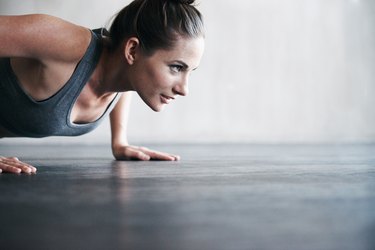
A colonoscopy is a procedure used to see inside the colon and rectum to detect inflammation, ulcers and abnormal growths. Polyps and small tumors can even be removed during the procedure. The National Institute of Diabetes and Digestive and Kidney Diseases indicates that your first screening colonoscopy should be at age 50 if you have no gastrointestinal symptoms or cancer risk factors. There is no reason why you can't exercise after a colonoscopy following a brief recovery period.
Tip
You will likely be able to resume your regular exercise routine 24 hours after a colonoscopy.
Video of the Day
Video of the Day
Prep for the Procedure
You may want to schedule an exercise routine around preparation for a colonoscopy, as your body is depleted of solid food for a short time. All solids must be emptied from the gastrointestinal tract by consuming a clear liquid diet one to three days prior to the procedure. Clear liquids include fat-free broth, strained fruit juice, water, plain coffee or tea, sports drinks like Gatorade and gelatin.
Don't drink liquids that contain purple or red dyes prior to a colonoscopy. A laxative or enema preparation is usually required the afternoon or evening before a colonoscopy. You need to inform your doctor of all diagnosed medical conditions and medications you are taking so he can provide you with specific instructions.
Understand the Procedure
A colonoscopy usually causes minor discomfort and is about a 30- to 60-minute outpatient procedure. When you first enter the exam room, you will be asked to lie on your side on an examination table; you will be sedated to help you relax and minimize any discomfort.
A colonoscope with a small camera on the end is moved through your large intestine, which is inflated for a better view. Then, the colonoscope is withdrawn so the lining can be examined. If necessary, the doctor performs a biopsy, removes polyps and small tumors and seals areas of bleeding.
Recovery From the Sedation
Following a colonoscopy, you will be taken to a recovery room and may stay there for one or two hours. Your sedation will begin to wear off during the recovery period, but you will still need someone to drive you home for safety. You may experience abdominal cramping or bloating because of the air injected during the procedure, but these feelings will shortly resolve.
Always follow your doctor's discharge instructions after a colonoscopy, but you should be able to resume a normal diet and light activity after a few hours of rest.
Read more: Complications After Colonoscopy
Exercise After Colonoscopy
According to the Oxford University Hospitals, you should not perform strenuous activities for 24 hours following a colonoscopy. This isn't due to the procedure itself, but the sedation that is required to perform the procedure.
If you have had a standard procedure, you should be able to resume normal activities, including an exercise regimen, the day after a colonoscopy. If you are not sure about exercise after colonoscopy, consult your doctor.